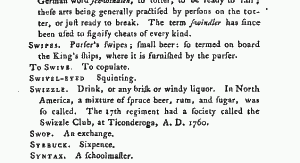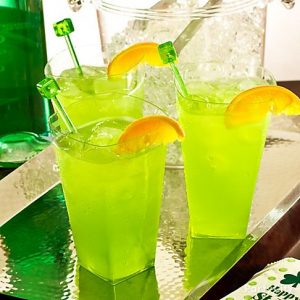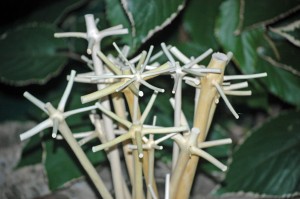With the launch of the El Dorado Swizzle Competition I thought I would let you all know a little about the history of this iconic drink.
When I started with El Dorado just over 4 years ago the master blender and distiller at DDL (who make El Dorado) had mentioned the Swizzle as popular and traditional rum drinks made in Guyana & so this became the drink that we focused on.

Swizzles are a type of mixed-drink that pre-dates the ‘cocktail’ and they are generally thought to be a Caribbean style of drink usually made with rum. From doing a quick search on the internet and in a few old cocktail books, it didn’t take long to discover that the swizzle was first mentioned in print in 1788 (as being in existence since at least 1760) in the brilliantly entitled A Classical Dictionary of Vulgar Tongue by Francis Grose (as seen in the picture to the right).
The place mentioned as the ‘Swizzle Club’ is listed as being a French/Canadian fort that was captured by the British in 1759, so the swizzle must have been a well known drink before this club was established for it to be named after it.
Swizzles are mentioned as Caribbean rum-based drinks in other early literature and the branch used to mix them is said to be from an ‘allspice’ or Quararibea turbinata tree/bush but more on that later.
The Swizzle itself is a rustic type of mixed drink that is named after the way it’s mixed rather than the ingredients – ‘rotating a special forked stick made from a root between the palms’. It is also often related to non-alcoholic drinks called ‘switchels’ which appear to be an early form of energy drink containing vinegar, honey/molasses/sugar and ginger which were given to thirsty farmers during harvest time or travellers, although these don’t seem to be mixed with a stick. There is also no recorded mention of a shot of Jager being dropped into a Switchel.
The guys in Guyana we had spoken to implied that the method of mixing with a forked stick had come over to the West Indies with the slave trade from Africa and that this was a common method of mixing drinks there, but there seems to be no historical evidence to support this which I could find.
Many islands claim the swizzle as their own (currently on the font of all factual information, Wikipedia, it appears that Bermuda did the most recent edit of the ‘Rum Swizzle’ page, but St Kitts, Trinidad, Barbados, Jamaica, St Thomas, Martininque and many other countries, including Guyana, have just as much of a link to it), and each of these islands have their own most famous recipe.
The bastion of rum-ness Trader Vic seems to have been a fan, listing quite a few and giving a nice bit of background to the drink as well. Many of these are refreshingly simple recipes that all follow the same structure – rum, a sour, a sweet, a bitter and some kind of non-alcoholic element.
The Green and Queen’s Park Swizzles

One of the most intriguing of these traditional recipes is the Green Swizzle, a drink mentioned in P.G. Wodehouse’s 1924 short story “The Rummy Affair of Old Biffy”. According to a lot of sources and recent articles the recipe to this drink is ‘lost in history, if it ever existed at all’ but when discussing the drink with Brian de Silva (who was at Rules at the time) we decided to get to the bottom of this classic drink, so we set about scouring as many old books as we could.
Initially a lot of the recipes we found called for crème de menthe, but most of these were from the 1940s onwards and to be honest the drink was horrid. Imagine someone trying to recreate a mojito without any fresh mint. This made us think these recipes were written after the original recipe was ‘lost in history’ and they just used the greenest thing they could get their hands on to match the name.
Trader Vic’s statement about his, crème de menthe containing, green swizzle recipe backed this opinion up as he said it was ‘not what Bertie had at Wembley’ (a nod to P.G. Wodehouse’s most famous character creation). Eventually we came across an article in a newspaper from 1910 that mentioned the ingredient that made the drink green was ‘wormwood bitters’. This was different, and it wasn’t a big jump to use absinthe as the ‘wormwood bitters’ ingredient.
This worked fantastically and made for a really refreshing, dry, aromatic swizzle which we decided was much more likely to make Bertie a happy toff.. Brian also experimented with making his own wormwood bitters – which made a delicious swizzle, but lacked the distinctive green colour.
Since then Darcy O’Neill has come to the same conclusion and his piece on the Green Swizzle goes into much more depth than I have room to here.
Another of the most famous swizzles is the Queen’s Park Swizzle which hails from the legendary Queen’s Park Hotel in Port of Spain, Trinidad. Trader Vic himself said this drink was the ‘most delightful form of anaesthesia given out today’ and contains rum (according to Dave Wondrich it would have been made with a heavy, fragrant Demerara rum from Guyana rather than the lighter Trinidad rums), fresh lime, fresh mint, Demerara sugar syrup and Angostura bitters. Although less well known than the Singapore Sling, it was created for a similar clientele – the Brit abroad (how the hell did we go from that to a pint of John Smiths and a Big Mac?).
Stick it to me

So much for the recipes, what about the all-important stick? The most widely accepted ‘correct’ stick to use is from the Caribbean Swizzle Stick Tree (Quararibea turbinata as mentioned earlier), but allspice is also mentioned in older literature. Both grow widely in the Caribbean, and have branches that fork, but the branches of the swizzle stick tree are slightly more suited to the job as well as sharing the name.
The sticks from both of these trees have aromatic bark on them, which, if used vigorously enough, would have given early swizzles a slightly bitter/spicy flavour. Our swizzle-making friends in Guyana said that the tree the swizzle sticks come from is commonly used to make tinctures or teas that are drunk for medicinal purposes.
The sticks used for mixing drinks nowadays are generally stripped of the bark – or worse, made from plastic – which might explain why most modern swizzle recipes include a dash of bitters.
As mentioned before, we aren’t sure whether swizzling originated in the Caribbean/South America or if the technique was brought over to that region from Africa/Europe, but to be honest, stirring things with sticks is hardly a high-tech ‘invention’. I’m sure a lot of people around the world who used sticks as stirrers discovered that rubbing it between the palms made it go faster (and become a bit more fun).
There is evidence of swizzling in Europe – specifically areas in Eastern Europe where pine trees grow. I was lucky enough to go to a talk on swizzles by the inspirational Stanislav Vadrna at Tales of the Cocktail last year. He showed how people in some villages used the top sections of pine trees (imagine the bit of your Christmas tree that you put the star on and the 4 or 5 branches that radiate out below this… now trim them down) to mix drinks. It’s not quite as widely used (or as related to cocktails) as Caribbean swizzles, but the technique is the same.
So that is a little insight into the Swizzle, a drink so dripping in history it was served at the world’s first cocktail party in London in 1924 held by novelist Alec Waugh. There is so much more out there to be found and I look forward to hearing all about your discoveries and tasting your Swizzles in the competition heats. So get your stick in one hand, a bottle of El Dorado in the other and get your swizzle on by entering the competition here. Oh did I mention the winner gets to come to Guyana?


